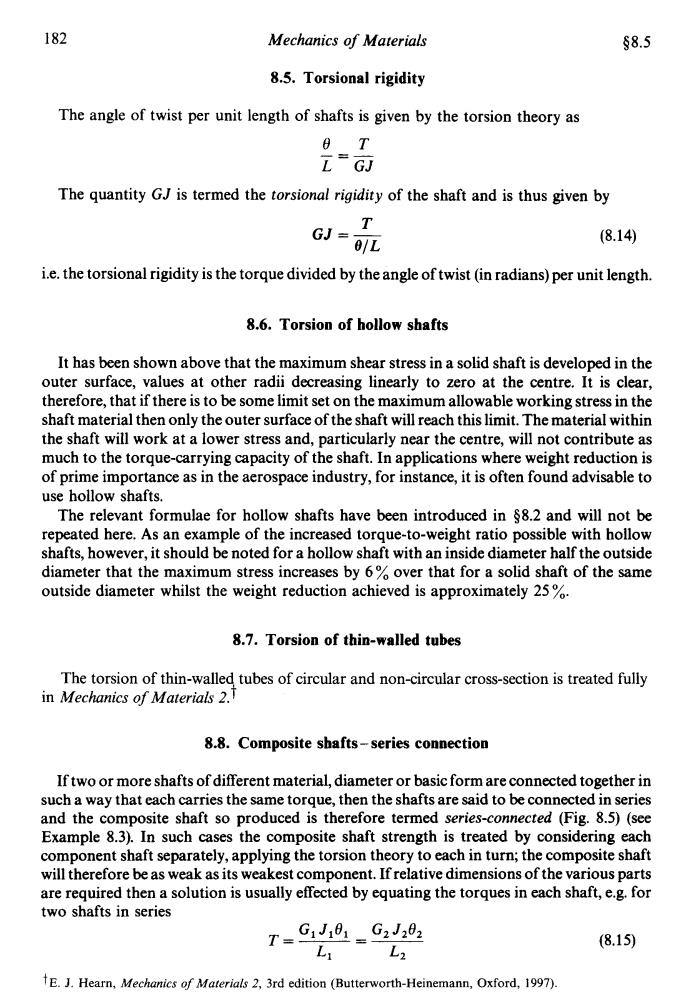正在加载图片...

182 Mechanics of Materials §8.5 8.5.Torsional rigidity The angle of twist per unit length of shafts is given by the torsion theory as 6 T L"G可 The quantity GJ is termed the torsional rigidity of the shaft and is thus given by GJ=T 0/L (8.14) i.e.the torsional rigidity is the torque divided by the angle of twist(in radians)per unit length. 8.6.Torsion of hollow shafts It has been shown above that the maximum shear stress in a solid shaft is developed in the outer surface,values at other radii decreasing linearly to zero at the centre.It is clear, therefore,that if there is to be some limit set on the maximum allowable working stress in the shaft material then only the outer surface of the shaft will reach this limit.The material within the shaft will work at a lower stress and,particularly near the centre,will not contribute as much to the torque-carrying capacity of the shaft.In applications where weight reduction is of prime importance as in the aerospace industry,for instance,it is often found advisable to use hollow shafts. The relevant formulae for hollow shafts have been introduced in $8.2 and will not be repeated here.As an example of the increased torque-to-weight ratio possible with hollow shafts,however,it should be noted for a hollow shaft with an inside diameter half the outside diameter that the maximum stress increases by 6%over that for a solid shaft of the same outside diameter whilst the weight reduction achieved is approximately 25 8.7.Torsion of thin-walled tubes The torsion of thin-walled tubes of circular and non-circular cross-section is treated fully in Mechanics of Materials 2. 8.8.Composite shafts-series connection If two or more shafts of different material,diameter or basic form are connected together in such a way that each carries the same torque,then the shafts are said to be connected in series and the composite shaft so produced is therefore termed series-connected (Fig.8.5)(see Example 8.3).In such cases the composite shaft strength is treated by considering each component shaft separately,applying the torsion theory to each in turn;the composite shaft will therefore be as weak as its weakest component.If relative dimensions of the various parts are required then a solution is usually effected by equating the torques in each shaft,e.g.for two shafts in series T=C1J8=G2J202 (8.15) L2 1E.J.Hearn,Mechanics of Materials 2,3rd edition(Butterworth-Heinemann,Oxford,1997).182 Mechanics of Materials $8.5 8.5. Torsional rigidity The angle of twist per unit length of shafts is given by the torsion theory as e~ L=GJ - The quantity GJ is termed the torsional rigidity of the shaft and is thus given by T GJ =- 91~ (8.14) i.e. the torsional rigidity is the torque divided by the angle of twist (in radians) per unit length. 8.6. Torsion of hollow shafts It has been shown above that the maximum shear stress in a solid shaft is developed in the outer surface, values at other radii decreasing linearly to zero at the centre. It is clear, therefore, that if there is to be some limit set on the maximum allowable working stress in the shaft material then only the outer surface of the shaft will reach this limit. The material within the shaft will work at a lower stress and, particularly near the centre, will not contribute as much to the torque-carrying capacity of the shaft. In applications where weight reduction is of prime importance as in the aerospace industry, for instance, it is often found advisable to use hollow shafts. The relevant formulae for hollow shafts have been introduced in $8.2 and will not be repeated here. As an example of the increased torque-to-weight ratio possible with hollow shafts, however, it should be noted for a hollow shaft with an inside diameter half the outside diameter that the maximum stress increases by 6 % over that for a solid shaft of the same outside diameter whilst the weight reduction achieved is approximately 25 %. 8.7. Torsion of thin-walled tubes The torsion of thin-walled tubes of circular and non-circular cross-section is treated fully in Mechanics of Materials 2. t 8.8. Composite shafts - series connection If two or more shafts of different material, diameter or basic form are connected together in such a way that each carries the same torque, then the shafts are said to be connected in series and the composite shaft so produced is therefore termed series-connected (Fig. 8.5) (see Example 8.3). In such cases the composite shaft strength is treated by considering each component shaft separately, applying the torsion theory to each in turn; the composite shaft will therefore be as weak as its weakest component. If relative dimensions of the various parts are required then a solution is usually effected by equating the torques in each shaft, e.g. for two shafts in series T=----- GlJlO1 =- Ll L2 t E. J. Hearn, Mechanics of Materials 2, 3rd edition (Butterworth-Heinemann, Oxford, 1997). (8.15)